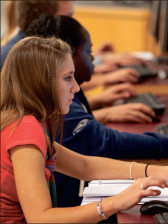The Integrated Learning Resource Center (ILRC) did not exist in the 70s and by the 80s a few students were bringing a new gadget called a laptop to school.

Tech rules — Classrooms and computer labs are equipped with PCs and Macs, and students have access to campus wide wireless internet. Photo credit: Ruth Bibby
The 90s ushered in the computer lab and as buildings went up, miles of hard wire cable were run to connect the computers to the world wide web. By 2000, Liberty met the increase in computer demand with a centralized computer lab and new wireless technology that created a massive web of unseen signals covering the campus.
Over the past few years Liberty has been working constantly to give students the best wireless connection on campus possible. The work that goes on behind the scenes in order to keep the internet easy access often goes unnoticed unless there is a glitch.
In 2008, the campus switched over to Bradford Endpoint Compliance System from Cisco Clean Access. This change eliminated the need for students to constantly enter their information into their computers in order to access the internet, according to Chief Information Officer Matthew Zealand.
Bradford is the system which provides protection for students against potential computer viruses. This particular system is significantly less time consuming for students to use than Cisco Clean Access. Students only have to go through the steps to connect to the internet on a rare occasion as opposed to every time they need to get online.
Students are also able to log onto the network via guest mode, a path that allows temporary internet access without requiring the typical steps involved in the connection process.
The campus is currently ranging between 95 and 98 percent wireless, which is provided through Aruba. The sections that do not have wireless access include places that students do not typically need connection, such as the bookstore parking lot, according to Zealand.
Over 700 access points have been strategically positioned throughout the campus in order to give students a positive wireless experience. Each access point can provide service to a maximum of 35 students, according to Zealand.
What students don’t realize is that as iPads, iPhones, Androids and other similar technology begins to increase in popularity, the need for wireless access increases as well. A student with a laptop and an iPhone require the use of two of the 35 spots available for wireless connection.
As technology continues to change, the university has been working constantly to keep up with the students’ needs in this area.
The access points installed around campus appear in the form of small boxes mounted to the walls or the ceiling in the area in need of wireless connection. Each box is outfitted with several antennae.
“I had never even noticed those before today,” freshman Megan Stone said. “I imagine that not many students have.”
Buildings such as DeMoss have been outfitted with more access points than other buildings on campus as a direct result of the large number of students who prefer to use their laptops in the ILRC.
Areas such as the courtyard and the lawn around the Prayer Chapel have wireless internet through the access points located in the buildings surrounding them. The connection may vary in places such as these depending on the amount of users and the distance to the nearest access point.
The Information Technology department takes the time to review the number of users on each access point on a monthly basis. This allows the department to add or remove the access points based on supply and demand.
Zealand encourages students who are having difficulties with their connection to the internet to obtain a help ticket from the Information Technology Help Desk.
“The more they get that information to us, the more we can respond to their needs,” Zealand said. “We count on the students to help with that feedback.”